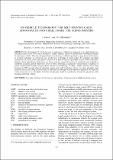| dc.contributor.author | Yang, J. | |
| dc.contributor.author | Coughlin, Joseph F | |
| dc.date.accessioned | 2016-12-21T16:28:04Z | |
| dc.date.available | 2016-12-21T16:28:04Z | |
| dc.date.issued | 2014-03 | |
| dc.date.submitted | 2013-12 | |
| dc.identifier.issn | 1229-9138 | |
| dc.identifier.issn | 1976-3832 | |
| dc.identifier.uri | http://hdl.handle.net/1721.1/105917 | |
| dc.description.abstract | The development of self-driving cars or autonomous vehicles has progressed at an unanticipated pace. Ironically, the driver or the driver-vehicle interaction is a largely neglected factor in the development of enabling technologies for autonomous vehicles. Therefore, this paper discusses the advantages and challenges faced by aging drivers with reference to in-vehicle technology for self-driving cars, on the basis of findings of recent studies. We summarize age-related characteristics of sensory, motor, and cognitive functions on the basis of extensive age-related research, which can provide a familiar to better aging drivers. Furthermore, we discuss some key aspects that need to be considered, such as familar to learnability, acceptance, and net effectiveness of new in-vehicle technology, as addressed in relevant studies. In addition, we present research-based examples on aging drivers and advanced technology, including a holistic approach that is being developed by MIT AgeLab, advanced navigation systems, and health monitoring systems. This paper anticipates many questions that may arise owing to the interaction of autonomous technologies with an older driver population. We expect the results of our study to be a foundation for further developments toward the consideration of needs of aging drivers while designing self-driving vehicles. | en_US |
| dc.description.sponsorship | Korea (South). Ministry of Trade, Industry and Energy (Technology Innovation Program 1004761) | en_US |
| dc.description.sponsorship | Kookmin University. Faculty Research Program | en_US |
| dc.description.sponsorship | New England University Transportation Center | en_US |
| dc.description.sponsorship | Santos Family Foundation | en_US |
| dc.publisher | The Korean Society of Automotive Engineers | en_US |
| dc.relation.isversionof | http://dx.doi.org/10.1007/s12239-014-0034-6 | en_US |
| dc.rights | Article is made available in accordance with the publisher's policy and may be subject to US copyright law. Please refer to the publisher's site for terms of use. | en_US |
| dc.source | The Korean Society of Automotive Engineers | en_US |
| dc.title | In-vehicle technology for self-driving cars: Advantages and challenges for aging drivers | en_US |
| dc.type | Article | en_US |
| dc.identifier.citation | Yang, J., and J. F. Coughlin. “In-Vehicle Technology for Self-Driving Cars: Advantages and Challenges for Aging Drivers.” International Journal of Automotive Technology 15.2 (2014): 333–340. | en_US |
| dc.contributor.department | Massachusetts Institute of Technology. Center for Transportation & Logistics | en_US |
| dc.contributor.department | Massachusetts Institute of Technology. Engineering Systems Division | en_US |
| dc.contributor.mitauthor | Coughlin, Joseph F | |
| dc.relation.journal | International Journal of Automotive Technology | en_US |
| dc.eprint.version | Author's final manuscript | en_US |
| dc.type.uri | http://purl.org/eprint/type/JournalArticle | en_US |
| eprint.status | http://purl.org/eprint/status/PeerReviewed | en_US |
| dc.date.updated | 2016-08-18T15:47:26Z | |
| dc.language.rfc3066 | en | |
| dc.rights.holder | The Korean Society of Automotive Engineers and Springer-Verlag Berlin Heidelberg | |
| dspace.orderedauthors | Yang, J.; Coughlin, J. F. | en_US |
| dspace.embargo.terms | N | en |
| mit.license | PUBLISHER_POLICY | en_US |
